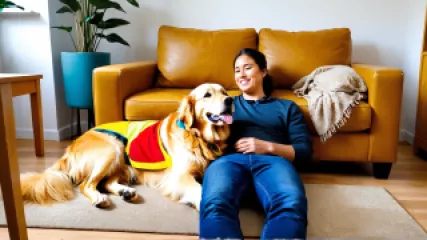My Unexpected Journey with Therapy Animals
My Unexpected Journey with Therapy Animals
It was a chilly autumn day when I first stepped through the doors of the mental health clinic, unsure of what to expect. As I nervously fidgeted in the waiting room, my eyes were immediately drawn to a gentle-looking golden retriever lounging by the receptionist's desk. To my surprise, the receptionist greeted me with a warm smile and informed me that the dog, named Loki, was a certified therapy animal who would be present during my counseling session.
I had heard of animal-assisted therapy before, but I never imagined it would be a part of my own journey towards better mental health. As a lifelong introvert, the prospect of opening up to a therapist was daunting enough, let alone the addition of a furry companion. However, the moment Loki padded over and rested his head in my lap, I felt an immediate sense of calm wash over me.
My therapist, Loren Cox, explained that the presence of therapy animals like Loki can have a profound impact on the therapeutic process. Studies have shown that interacting with therapy animals can reduce anxiety, lower blood pressure, and even release endorphins that promote feelings of well-being. As someone who had struggled with anxiety and depression for years, I was intrigued and cautiously optimistic about this unexpected addition to my treatment plan.
The Power of Unconditional Acceptance
Over the course of the next few months, Loki became a constant and comforting presence during my weekly therapy sessions. Whenever I would start to feel overwhelmed or hesitant to open up, Loki would gently nudge my hand, encouraging me to pet him and ground myself in the present moment.
Unlike my interactions with other people, which were often colored by judgment or preconceptions, Loki's acceptance of me was unconditional. He didn't care about my past, my flaws, or my struggles – he simply offered his unwavering companionship and a non-judgmental ear (or rather, a wet nose).
As I began to share my innermost thoughts and feelings with Loren, Loki would often rest his head on my lap, his soulful eyes gazing up at me with an almost uncanny understanding. It was as if he knew exactly when I needed that extra bit of support, and he was always there to provide it without ever asking for anything in return.
Unlocking the Power of Nonverbal Communication
One of the most profound aspects of my experience with animal-assisted therapy was the way it unlocked new avenues of communication and self-expression. As an introvert, I had always struggled to find the right words to articulate my emotions, often finding myself tongue-tied and unable to convey the depth of my feelings.
With Loki by my side, however, I found that I was able to communicate in ways that transcended spoken language. Whether it was the gentle brushing of his fur, the comforting weight of his head on my lap, or the way he would gaze into my eyes with unwavering empathy, Loki provided a nonverbal means of expressing myself that I had never experienced before.
Loren, my therapist, observed this phenomenon and encouraged me to explore the power of this nonverbal communication. She explained that interacting with therapy animals can help individuals tap into their implicit, emotional responses, allowing them to access and process feelings that may have been difficult to articulate verbally.
As I engaged in this intuitive form of interaction with Loki, I began to gain a deeper understanding of my own emotional landscape. I found myself more attuned to the subtle nuances of my inner world, and I was able to explore and unpack complex thoughts and feelings that had previously eluded me.
The Transformative Power of Presence
Perhaps the most profound aspect of my experience with animal-assisted therapy was the way it helped me cultivate a deeper sense of presence and mindfulness. In a world that often moves at a breakneck pace, filled with constant distractions and demands on our attention, it can be easy to lose touch with the present moment.
But when I was with Loki, the world seemed to slow down. In his quiet, steadfast presence, I found myself drawn into the immediate, sensory experience of the here and now. The rhythmic sound of his breathing, the soft warmth of his fur, the gentle movements of his body – all of these sensations helped anchor me in the present, allowing me to let go of the anxious thoughts and worries that had so often consumed me.
Loren encouraged me to practice mindfulness exercises with Loki, such as slow, deep breathing and guided visualizations. As I followed her instructions, I noticed a profound shift in my mental and emotional state. The feelings of tension and unease that had plagued me for so long began to melt away, replaced by a sense of calm and clarity that I had rarely experienced before.
In those moments with Loki, I felt truly present, fully engaged with the world around me and deeply connected to my own inner landscape. It was as if the therapy animal had unlocked a doorway to a more authentic, grounded version of myself – one that had been obscured by the noise and distractions of everyday life.
The Ripple Effects of Animal-Assisted Therapy
As my weekly sessions with Loki and Loren continued, I began to notice a profound change not just in my own mental and emotional well-being, but in the various facets of my life. The sense of calm and presence that I had cultivated during our time together seemed to seep into every aspect of my existence, from my relationships with friends and family to my work and creative pursuits.
I found that I was better able to navigate the challenges and stresses of daily life, drawing on the lessons I had learned from my interactions with Loki. When I felt overwhelmed, I would take a deep breath, visualize Loki's comforting presence, and find the strength to soldier on. And when I needed to connect with others, I found that I was more attuned to their emotional states and better equipped to offer empathy and support.
Perhaps most importantly, my work with Loki and Loren helped me develop a deeper sense of self-acceptance and compassion. I had spent so much of my life feeling ashamed of my mental health struggles, believing that I was somehow flawed or deficient. But through the unconditional acceptance and understanding that Loki provided, I began to see myself in a new light – not as a problem to be fixed, but as a human being worthy of love and care.
This newfound self-acceptance had a profound impact on my relationships and my overall sense of well-being. I found that I was better able to set healthy boundaries, communicate my needs, and cultivate deeper, more meaningful connections with the people in my life. And as I continued to heal and grow, I also felt a growing desire to share my experience with others who might be struggling with similar challenges.
Paying it Forward
As my time with Loki and Loren drew to a close, I knew that I wanted to find a way to continue my involvement with animal-assisted therapy. I had seen firsthand the transformative power of this approach, and I was determined to share that gift with others who might be in need.
After much research and soul-searching, I decided to enroll in a program to become a certified therapy animal handler myself. I knew that the journey would be challenging, both emotionally and logistically, but the prospect of being able to provide the same kind of support and comfort that Loki had given me was too compelling to ignore.
Over the next several months, I worked tirelessly to train my own dog, a playful and affectionate golden retriever named Dock, to become a certified therapy animal. It was a rigorous process that involved obedience training, socialization exercises, and a comprehensive evaluation to ensure that Dock and I were ready to work with vulnerable populations.
But through it all, I was driven by a deep sense of purpose and a desire to pay forward the transformative experience that I had undergone with Loki. I knew that there were countless individuals out there who were struggling with mental health challenges, and I was determined to do whatever I could to help them find the same sense of peace, connection, and self-acceptance that I had discovered.
Spreading the Power of Animal-Assisted Therapy
When Dock and I finally received our certification, it was a moment of immense pride and joy. I knew that we were embarking on a journey that would not only enrich our own lives, but also the lives of those we would have the privilege of working with.
And so, with Dock by my side, I began to volunteer at local mental health clinics, nursing homes, and even schools – sharing the power of animal-assisted therapy with anyone who was open to experiencing it. Whether it was helping a shy child open up during a counseling session, or bringing a smile to the face of a lonely older adult, the impact of Dock's presence was profound and immediate.
As I witnessed the transformative effects of this approach time and time again, I became increasingly passionate about advocating for the wider adoption of animal-assisted therapy. I collaborated with local mental health organizations to develop training programs for therapy animal handlers, and I even began to explore the possibility of starting my own non-profit dedicated to this cause.
But beyond the practical, logistical aspects of this work, I found that my own personal journey with Loki and Dock had instilled in me a deep sense of empathy and a profound appreciation for the power of the human-animal bond. I knew that, at its core, animal-assisted therapy was not just about providing a service or a treatment modality – it was about fostering genuine connection, cultivating mindfulness and presence, and helping individuals rediscover their inherent worth and dignity.
A Lasting Legacy
As I look back on my unexpected journey with therapy animals, I am struck by the profound impact it has had on every facet of my life. What began as a hesitant first step into the world of mental health counseling has blossomed into a deep and abiding passion – one that has not only transformed my own life, but also the lives of countless others who have had the privilege of experiencing the magic of animal-assisted therapy.
In many ways, my work with Loki and Dock has become a part of my identity, a core aspect of who I am and how I choose to show up in the world. It has imbued me with a sense of purpose and a deep appreciation for the power of the human-animal bond – a bond that, I firmly believe, has the potential to heal, to soothe, and to inspire us all.
And as I look to the future, I am filled with a sense of hope and excitement for the ways in which this approach to mental health and well-being can continue to evolve and grow. Whether it's through the expansion of virtual animal-assisted therapy programs, the integration of therapy animals into traditional counseling modalities, or the development of new and innovative ways to harness the power of the human-animal connection, I am convinced that the future of mental health care lies in embracing the transformative potential of therapy animals.
For me, this journey has been one of unexpected growth, profound self-discovery, and a deep, abiding sense of purpose. And as I continue to share my story and advocate for the wider adoption of animal-assisted therapy, I am filled with a profound gratitude for the furry companions who have walked beside me, guiding me towards a more authentic, grounded, and compassionate version of myself.






